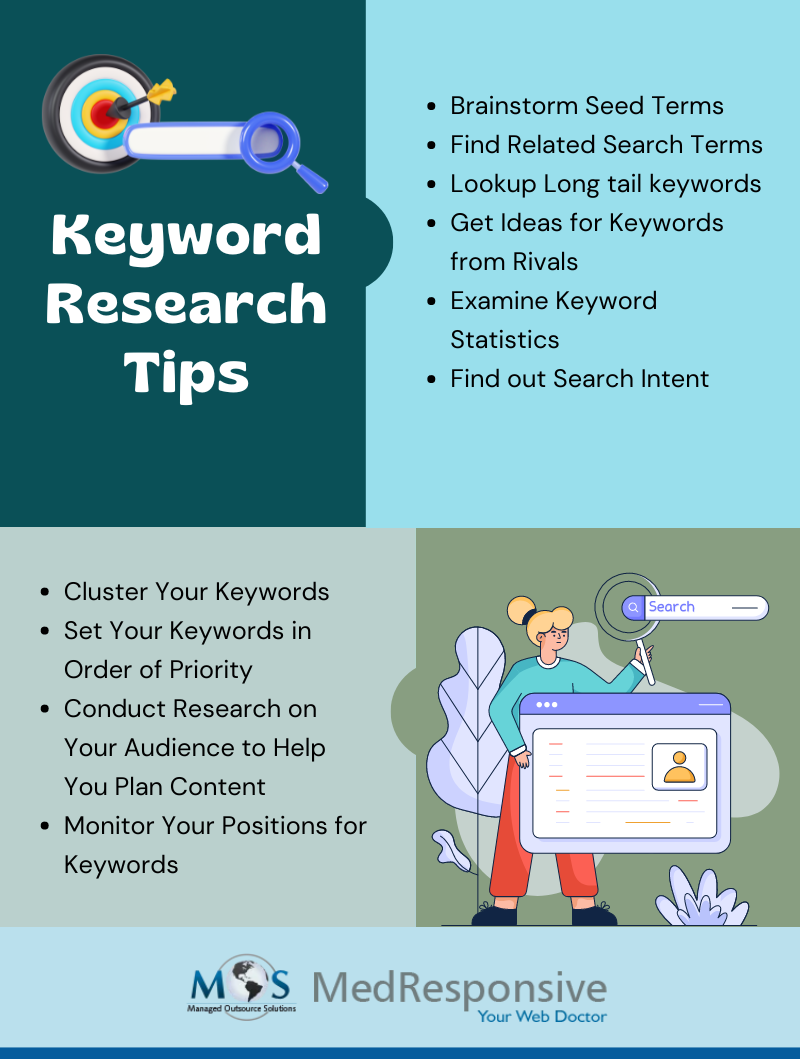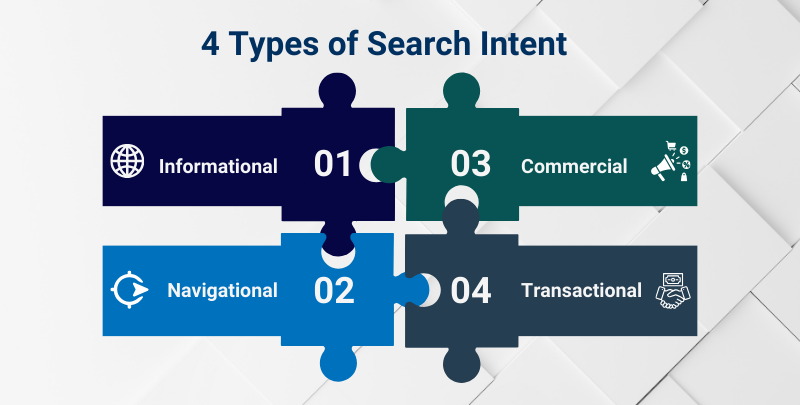Using the right keywords are crucial to optimize your website. Strong keyword research is the foundation of a good SEO campaign and can help you develop your content around the right keywords your target audience use. An organic SEO company can help you find the right keywords and use them to optimize your content, increasing your visibility online based on competition and search intent.
Tips for Keyword Research
Keyword research involves identifying and analyzing search phrases users type into search engines to get information about a business or product they’re interested in. Here is a comprehensive checklist for conducting keyword research to raise your search engine ranking organically and attract targeted traffic.
- Brainstorm Seed Terms: Coming up with ideas for seed keywords should be the first step. Seed keywords are general terms or expressions associated with your brand, goods, services, or specialty. They serve as the basis for your keyword investigation procedure help you start building your collection of keywords. Consider the issues you want to resolve first. Additionally, think about the search phrases that customers would use to find your kind of company. If you are a car dealer, some of your seed keywords might be “car buying guides” or “best new cars” etc.
- Find Related Search Terms: Using your list of seed keywords, you can now determine which pertinent search terms to include in your text. The Keyword Magic Tool is a great resource for analyzing an entire search market. Enter a seed term in Magic Tool and you’ll receive a ton of useful analytics and suggestions for similar keywords. Then, focus on terms that are especially pertinent to your niche using the suggested groupings and subgroups on the left. By doing this for a few seed keywords, you’ll obtain a comprehensive understanding of your niche and the main subjects.
- Lookup Long tail keywords: Highly targeted search terms with low search volume and minimal competition are known as long-tail keywords. Generally speaking, these terms are simpler to rank for. They are excellent for developing topical authority and eventually improving your ranking for more competitive terms. Due of their extreme specificity, they frequently attract extremely focused traffic. This indicates that users like them, are probably very interested in your offerings, and may be inclined to become your customers. A seed keyword such as “shoes” might receive hundreds of thousands of searches per month, for instance. A particularly specialized long-tail query with a far lower search traffic is “women’s running shoes size 8”. A person looking for “women’s running shoes size 8” is far more likely to make a purchase than someone looking for “shoes.” Use the Magic Tool to enter a seed term in order to find long-tail keywords. Examine the top few terms, as well as the keyword density and “Volume” (monthly search volume). This will give you a list of strong long-tail keywords.
- Get Ideas for Keywords from Rivals: Finding out what your rivals are ranking for should be the next item on your checklist for keyword research. If your competition is ranking for certain terms, these are likely to be useful keywords for your site. Conducting rival keyword analysis can help you find keywords that you aren’t ranking for, but your rivals are. Use the Keyword Gap tool to locate them. Add up to four competitor URLs along with your own. Next, select “Compare”. Click the “Missing” filter in the table by scrolling down to view the keywords that all of your rivals rank for but you don’t. Producing content for each of these keywords can bring in more traffic.
- Examine Keyword Statistics: Even if you generate a long list of keywords to target, each one doesn’t offer the same value. While it may be impossible to rank for some, others will generate little to no website traffic or conversions. That’s why it’s necessary to examine the metrics of every keyword before deciding which to target. After entering the selected search words into the Keyword Overview tool, you can examine useful metrics for several search terms, including:
- Volume of searches: The average number of times a keyword is searched for every month
- Keyword difficulty: How difficult it is to rank for that keyword in the top 10 results
- CPC: The average cost to marketers when a user clicks on an advertisement that is brought up by that term
- SERP attributes: Distinctive outcomes on Google’s results pages that don’t belong in the standard listings
Target keywords that have higher search volumes but low to medium difficulty scores typically present favorable traffic opportunities without being extremely difficult to rank for. This will assist you in narrowing down your selection to a select group of practical, business-related keywords for your SEO campaign.
- Identify Search Intent: A user’s search engine query is motivated by their search intent. Comprehension of search intent is essential for keyword research, considering that Google wants to give people results that are relevant to them. Understanding user intent will enable you to produce content that has a higher chance of ranking.
There are four primary categories of search intent:
| Informational | People are searching for details (such “what is keyword research” or “how to start a blog”). These questions show a drive to discover information or solutions. |
| Navigational | People use search terms like “semrush” or “facebook login” to find a certain website or online location. |
| Commercial | Before making a purchase, users are interested in learning more about goods or services. Search terms such as “crm software” or “best email marketing tools” are meant to be commercial. |
| Transactional | Consumers are prepared to buy something or finish a particular task (like “download or subscription”). |
With Keyword Overview, determining the intent of any keyword is simple. Simply search for the “Intent” widget. Understanding each term’s intent will help you create content that directly deals with it.
- Cluster Your Keywords: The practice of assembling related terms into groups according to intent is known as keyword clustering. It can improve the ranking of each of your pages for several keywords. With Keyword Manager, clustering keywords is simple. Simply open your keyword list or import your keywords by clicking “create a regular list.” Based on the topic and aim, the tool will automatically arrange related terms. Click the arrow to view all of the cluster’s keywords along with their metrics. The term with the highest search volume is the the main keyword a page targets or the primary keyword for a specific cluster. The remaining terms are supplementary keywords, which are alterations that bolster the main term. Utilize these clusters for mapping keywords. This involves strategically allocating keywords to your website’s pages. This can assist you in finding and filling content gaps, preventing keyword cannibalization, and optimizing your site for the most relevant keywords.
- Set Your Keywords in Order of Priority: Determining a keyword’s impact on your business objectives is the first step in prioritizing it. Segment your keyword lists according to their position in the content marketing funnel to achieve this:
- Top-of-the-funnel (ToFu) keywords: These have a high search volume and show that consumers are in the awareness stage. They’re perfect for increasing brand awareness and drawing in new customers.
- Middle-of-the-funnel (MoFu) keywords: Show that users are weighing their alternatives and have moderate search volumes. These more focused keywords work well for emphasizing your value proposition and fostering lead nurturing.
- Keywords for the bottom-of-the-funnel (BoFu): It possess increased buyer intent but reduced search volume. The people that are looking for these transactional keywords are prepared to buy.
Pay attention to BoFu keywords that are closely related to your main offering, since these have the best chance of increasing sales. Next, focus on MoFu keywords that inform potential customers about your offerings. Incorporating ToFu keywords at the beginning of your funnel will draw in new viewers and raise brand exposure.
In order to draw in, nurture, and convert clients, a successful keyword strategy targets questions at every point of the funnel. But you can achieve your business objectives more quickly if you start at the bottom of the funnel.
- Conduct Research on Your Audience to Plan Content Creation: The demographic you wish to reach with your marketing is known as your target audience. Common traits they share include age, gender, hobbies, and purchasing patterns. Knowing your target audience’s characteristics, interests, and other details will help you create content that appeals to them. To define your own audience, you can conduct research about your competitors’ audience.
Open One2Target, type in the domains of up to five rivals, then select “Analyze.” A comprehensive summary of the audience’s online activity, socioeconomic status, and demographics will be displayed. Analyzing the data may reveal insights such as:
- The age range of the majority of your audience
- If they work full-time jobs, are students, or are unemployed
- Which social media sites do they frequent and so on
Make use of all of this knowledge when crafting the content that features your top keyword clusters.
- Monitor Your Keyword Ranking: Track your keyword rankings once you’ve completed your checklist for keyword research and created content. This is important to understand your website’s visibility and how much organic traffic it can attract. Use this information to assess the success of your SEO campaign and pinpoint areas that need more effort. The Position Tracking tool can help you:
- Keep track of thousands of keywords every day.
- Find opportunities to get featured in snippets.
- Analyze competitors’ rankings for the same keywords.
Add the keywords you wish to track to a Position Tracking project after configuring it. Selecting “Send me weekly ranking updates via email” will ensure you stay informed of any modifications or reductions in visibility.
Implement these best keyword research tips to stay ahead of the competition and maximize your online presence.
Want to know the latest trends in Keyword Research?
Read our post, 5 Best Keyword Research Trends for Your Website
Effective keyword research is a critical component of any successful SEO strategy. By understanding your audience, leveraging the right tools, and staying up-to-date with trends, you can optimize your content to attract and engage more visitors. Partnering with an organic SEO company can further enhance your efforts, providing the expertise and resources needed to achieve sustainable organic growth.





